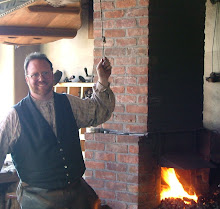 The Farmers’ Museum has more draft power than just our horse Zeb. There are also Jigs and Buckwheat, the Devon Shorthorn Working Steers. Oxen were a much more common source of draft power in the 1840s than in the present. Oxen are strong, readily available on the farm, and able to thrive on feed a horse wouldn’t eat. Today, they have a reputation for being slow. While it is true that they don’t have the gallop of a horse, oxen have good speed while pulling heavy loads like plows and logs.
The Farmers’ Museum has more draft power than just our horse Zeb. There are also Jigs and Buckwheat, the Devon Shorthorn Working Steers. Oxen were a much more common source of draft power in the 1840s than in the present. Oxen are strong, readily available on the farm, and able to thrive on feed a horse wouldn’t eat. Today, they have a reputation for being slow. While it is true that they don’t have the gallop of a horse, oxen have good speed while pulling heavy loads like plows and logs.Most people know that horses wear shoes to protect their hooves from wear and to improve traction. Many don’t know that oxen can be shod as well. Oxen have a split hoof, and can wear two shoes on each foot. Thus a fully shod ox wears 8 shoes. We have a couple of forged ox shoes at the blacksmith shop.
 For a look at how ox shoes were traditionally forged in Northern Europe try viewing this 1923 film: “Nail and Ox shoe Smith”. It is almost ten minutes long, and requires a high speed connection to stream the video. (It is embedded below, but you can also follow the link)
For a look at how ox shoes were traditionally forged in Northern Europe try viewing this 1923 film: “Nail and Ox shoe Smith”. It is almost ten minutes long, and requires a high speed connection to stream the video. (It is embedded below, but you can also follow the link)The first two minutes show a rural smith in Sweden making nails. The rest of the film documents two smiths forging first nails, then ox shoes. They make both a normal ox shoe and a winter shoe called an “Ice Nail”. The winter shoes have an iron spike on the bottom for traction. This black and white film seems to be part of an effort to document rural and disappearing trades. The smith and striker work very smoothly and fast. You can tell they have made hundreds of these shoes by the way they handle their tools.

This blog is amazing!!!i stay impressive with the whole information because is absolutely interesting and wonderful .I like the new ideas raised in this blog. Simply wonderful. i love the shoes, it drives me crazy.i usually go shopping, specially to buy shoes.
ReplyDeletebuy viagra
so that is how they make an ox shoe nail. its pretty long, how come does the ox doesn't hurt?
ReplyDeletedickies scrubs
I am looking for two sets of used oxen shoes, for a display. Can you help me or recommend someone.
ReplyDeletegpcobb9980@att.net
I am looking for ox shoes, any condition can someone please advise, serious replies only please 218-282-0286
ReplyDeleteThis is an informative blog! I had also read a kind of similar thing a few days before - super p force online
ReplyDeletepeople are funnnnnnn
ReplyDelete